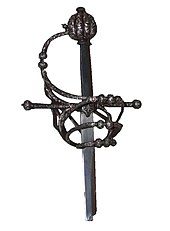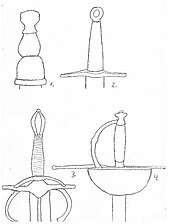Vessel (weapon)
The vessel includes all parts of a grip weapon ( cutting , stabbing and thrusting weapons with a pronounced grip ), which are used to grasp the same, to defend against the enemy weapon, to protect the hand and to hold these parts together. A bladed weapon therefore consists of a blade , vessel and sheath .
Components
The components of a vessel are:
- Handle or handle ; this is grasped with the hand
- Knob ; Completion of the handle
- Hand protection elements to protect the hand
- Parrying elements to defend against the opponent's blade; often at the same time double function as hand protection elements
Vascular groups
The vessels can be designed from very simple to complex. They are basically divided into the following groups (numbers correspond to the figures in Figures 1 and 2):
- simple vessel z. B. to Bauernwehr , Schaschka , or Dirk (picture 1)
- simple cross vessel z. B. on sword , Faschi knife , large knife (picture 1)
- complicated cross vessel z. B. on sword and rapier (picture 1)
- Bell jar z. B. on the sword (picture 1)
- simple knuckle-bow vessel z. B. on the saber (picture 2)
- Mesh basket vessel z. B. to Schiavona , Mortuary Sword (picture 2)
literature
- Gerhard Seifert: Technical terms of edged weapons. 2007 Technical terms of edged weapons science (PDF file; 3.66 MB)
- Michael Störmer: The armory: a compendium of medieval melee weapons. G&S Verlag GmbH, 1999, ISBN 9783925698460 , pp. 11-13 [1]
- Friedrich Joseph Greven: Lectures on the most important branches of war science: held in Göttingen. Vandenhoeck u. Ruprecht, 1831, p. 562 [2]
- Franz Müller: Hand-weapon theory or: all types of fire rifles in use now and bare weapons of the Imperial and Royal Austrian Army. Verlag Haase, 1844, pp. 162-164 [3]


